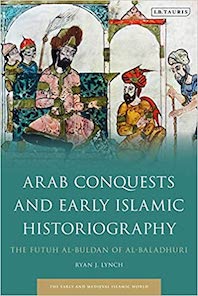Lynch (Ryan J.), Arab Conquests and Early Islamic Historiography: The Futuh Al-buldan of Al-baladhuri, I.B. Tauris, 2021, 272 p. ISBN 978-0755644681
Author
Ryan J. Lynch is Assistant Professor of History at Columbus State University, USA. A specialist in early Islamic history and early Arabic historiography, he received his DPhil from the University of Oxford. His research has appeared in journals such as the Journal of the American Oriental Society and in reference publications such as The Oxford Dictionary of Late Antiquity.
Presentation

Of the available sources for Islamic history between the seventh and eighth centuries CE, few are of greater importance than al-Baladhuri’s Kitab Futu? al-buldan (The Book of the Conquest of Lands). Written in Arabic by a ninth-century Muslim scholar working at the court of the ’Abbasid caliphs, the Futu?’s content covers many important matters at the beginning of Islamic history. It informs its audience of the major events of the early Islamic conquests, the settlement of Muslims in the conquered territories and their experiences therein, and the origins and development of the early Islamic state. Questions over the text’s construction, purpose, and reception, however, have largely been ignored in current scholarship. This is despite both the text’s important historical material and its crucial early date of creation. It has become commonplace for researchers to turn to the Futu? for information on a specific location or topic, but to ignore the grander - and, in many ways, more straightforward - questions over the text’s creation and limitations. This book looks to correct these gaps in knowledge by investigating the context, form, construction, content, and early reception history of al-Baladhuri’s text.
Content
Introduction: The Early Arabic Historical Tradition and the Problematic Nature of the “Narrative Sources”
Chapter 1: The Text of Futu? al-buldan
Chapter 3: The Sources of Futu? al-buldan
Chapter 4: The Content and Themes of the Text
Chapter 5: The Matter of Genre and the Classification of Futu? al-buldan
Chapter 6: The Medieval Reception and Reuse of the Futu?
Conclusion: A Portrait of Authority
Bibliography
Credit Photo : Egyptian papyrus PERF 558 containing a bilingual Greek-Arabic tax receipt dated from 643 AD
